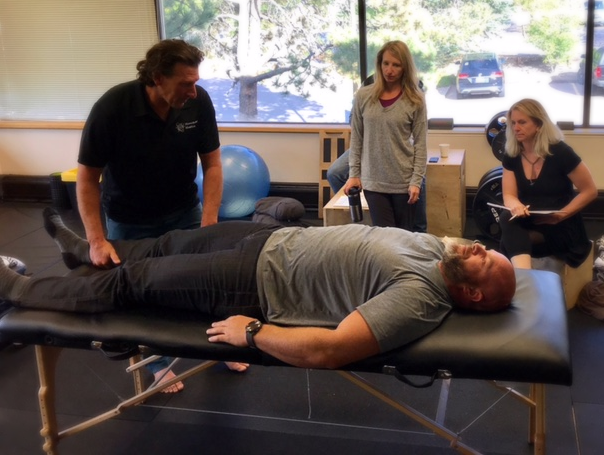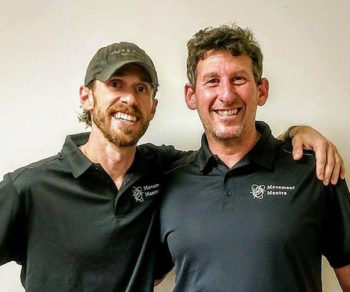
By streamlining assessment via the considerations outlined in Dynamic Neuromuscular Assessment™ Seminars, you can save yourself and your client a lot of time and energy. Let’s illustrate this with several of the considerations that make DNA™ unique.
First Consideration: Keeping the container safe
DNA™ teaches us effective ways to monitor the response of our client’s nervous system in order to keep the container safe. Our nervous system chooses adaptation strategies as a protection mechanism. These strategies have a priority. There is the primary compensation and the potential for multiple secondary compensations. These secondary compensations boost the primary compensation. If we indiscriminately remove a secondary compensation, we are inadvertently creating a void in the container of our client’s coping strategies. The nervous system then must adapt to not having that available element. What the nervous system chooses to fill that void with may potentially be more maladaptive than the original coping strategy. This can happen in all three categories of the trine in Applied Kinesiology: movement and structure, physiology and subtle body energy, and limbic associations and emotions. The danger here is that if we kick out the leg in a three-legged stool…something is going to crash. This can become a big problem if the nervous system chooses to utilize the energy system from our physiology or limbic associations to bolster dysfunctional movement.
Second Consideration: Manual Muscle Testing can and will produced skewed results
Protocols we utilize in Dynamic Neuromuscular Assessment™ allow us to recognize when the false negative and the two false positives show up in MMT. There are two causes for this. First, the practitioner may have unresolved issues in their mind/body. As practitioners, we affect the outcome. Our expectations and projections, conscious and unconscious, have an impact on the testing results. The second cause is the response we are getting from the client. There are two false positives and one false negative that are constantly showing up in our MMT. If these are not vetted, our correlation of relationship and causation will be skewed. We need a specific process, or protocol like what is shared in DNA™, to double check when the movement response gives us faulty data.
Third Consideration: Global / Local / Global
Global assessment in DNA™ evaluates the ability of the nervous system to respond using feed-forward assessment. This allows the nervous system the opportunity to utilize the primary compensation. Then we can further vet the dysfunction by looking at the local components. The first global assessment gets us in the right neighborhood, the local components, or building blocks of movement, gets us to the right house. As we continue with the process we end up in the right room, in the right house in the right neighborhood. After we have vetted the primary driver, restored normal response, we can insert that back into the global movement for re-evaluation. The global local global approach is much faster at vetting the primary compensation. This is the opposite of the hit or miss strategy of relying on local assessment to resolve a presentation.
Fourth Consideration: Secondary compensation leads us astray from the primary driver
When we are evaluating movement, every dysfunction has the potential of multiple pieces. How we trace, or map, the dysfunctional components in DNA™ makes a difference in the outcome for your client. We must treat each piece as a potential symptom and completely vet the presentation before we employ a corrective strategy. This relates back to the first consideration and is a major tenet of DNA™, we do not want to remove a secondary coping strategy as that creates vulnerability. The mapping process specifically vets the dysfunctions to arrive at the primary dysfunction. Initially this may seem like the tortoise and the hare approach. The hare would be treating what they find as it presents itself. The tortoise looks at the complete presentation before using laser focused corrective strategies that have the most impact with the least amount of intervention.
Fifth Consideration: Specific Adaptation to Imposed Demand, the SAID principle is our ally in efficiency
DNA™ radically optimizes your assessment by implementing the SAID principle. The SAID principle has two primary ways it affects the outcome of our work. The first is the preliminary steps we take during the evaluation process. Does the process complete the map of the presentation? When it does, we can then cue the nervous system to all the elements that correlate to the primary dysfunction. When we employ a corrective, then the nervous system has an understanding of how these pieces interrelate. We then get the most value from the least amount of work. The second way the SAID principle affects the outcome is related to the corrective strategy itself. If we have not cued the nervous system appropriately, then the nervous system must interpret what, how and why the pieces fit together. Often, the nervous system is unable to fill in the missing pieces. When this happens, our corrective strategy will be temporary at best. This is why clients will return with the same presentation over and over. The nervous system is not getting enough information to make a sustainable change. Instead, when the environment load increases beyond capacity, the nervous system returns to a familiar coping strategy.
Let’s look at how these five considerations weave together in an evaluation process. This is an excerpt from a recent DNA™ Module One practicum.
Intention: Assessment of the breathing apparatus
Global Skill: QiGong Posture
Visual: appears that the diaphragms move out of alignment creating a lack of integrity in the core cylinder
MMT: Functional Dysfunctional Response: Correlation to Limbic Association
Local Components:
Sacrospinalis / multifidus – normally responsive
TVA – normally responsive
Pelvic Floor – functional dysfunctional
Vet Pelvic Floor:
Structural – L sub-occipitals TL
Vet L sub-occipitals – functional dysfunctional
Structural – R jaw TL
Vet R Jaw – functional dysfunctional
Limbic Association TL- same association as the global movement association
Double check our work:
Client TL’s the R Jaw
Retest PF and L sub-occipitals
Normal Response
Corrective:
Cue the associated movements into the nervous system (order matters)
Limbic hold on the Bennett points (a generic cranial hold while observing the breath)
Retest: (in the same order)
PF normal response
Sub-occipitals normal response
Jaw normal response
Re-insert local components back into the Global Movement
Normal Response!
Summary:
Using Dynamic Neuromuscular Assessment™ our first consideration is the safety of our client’s nervous system. We then add stability into the system. We did not remove coping strategies creating vulnerability. The old paradigm would indicate that we would have released sub-occipitals. If we would have tried to correct a dysfunctional component that is correlated to a limbic association, potentially the volume of that limbic input would increase. That would have essentially kicked the third leg out of the three-legged stool.
Limbic associations can have multiple layers mirroring the template of compensations with primary and secondary/s. We toned down the association. We did not necessarily remove or clear. We tone it down so that the nervous system can appropriately respond to the environment. There may be more work needed to effect sustainable change.
Using only one corrective – in the DNA™paradigm – we restored movement function to all the local components and the initial global assessment. That could not have happened if we did not utilize the SAID principle in our assessment and correction.

